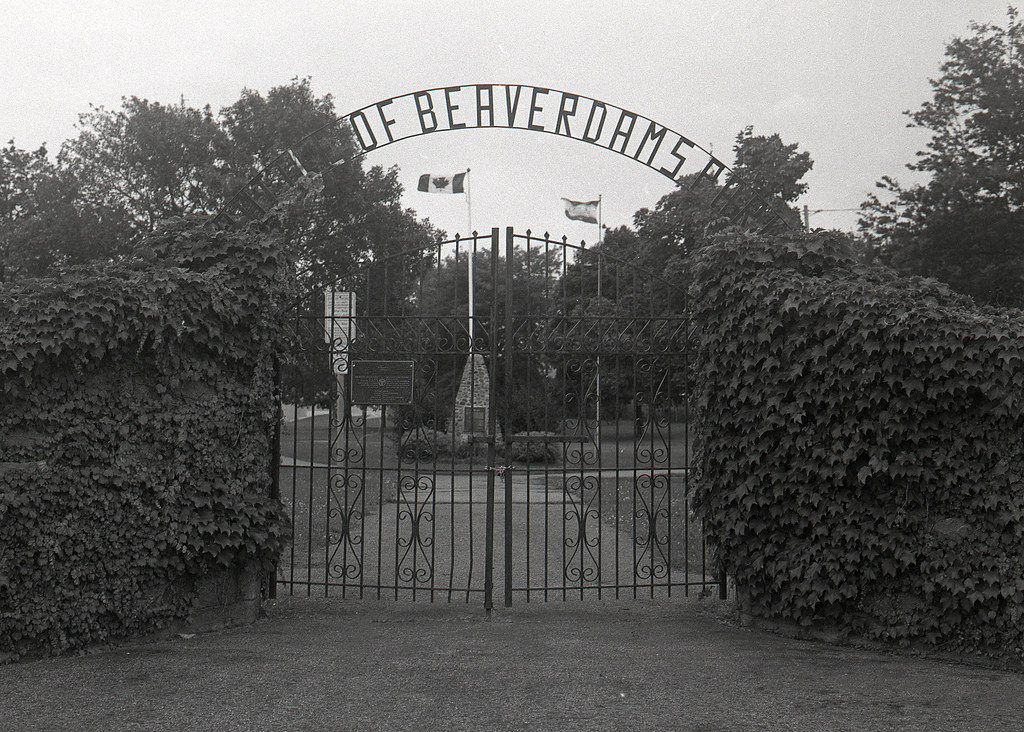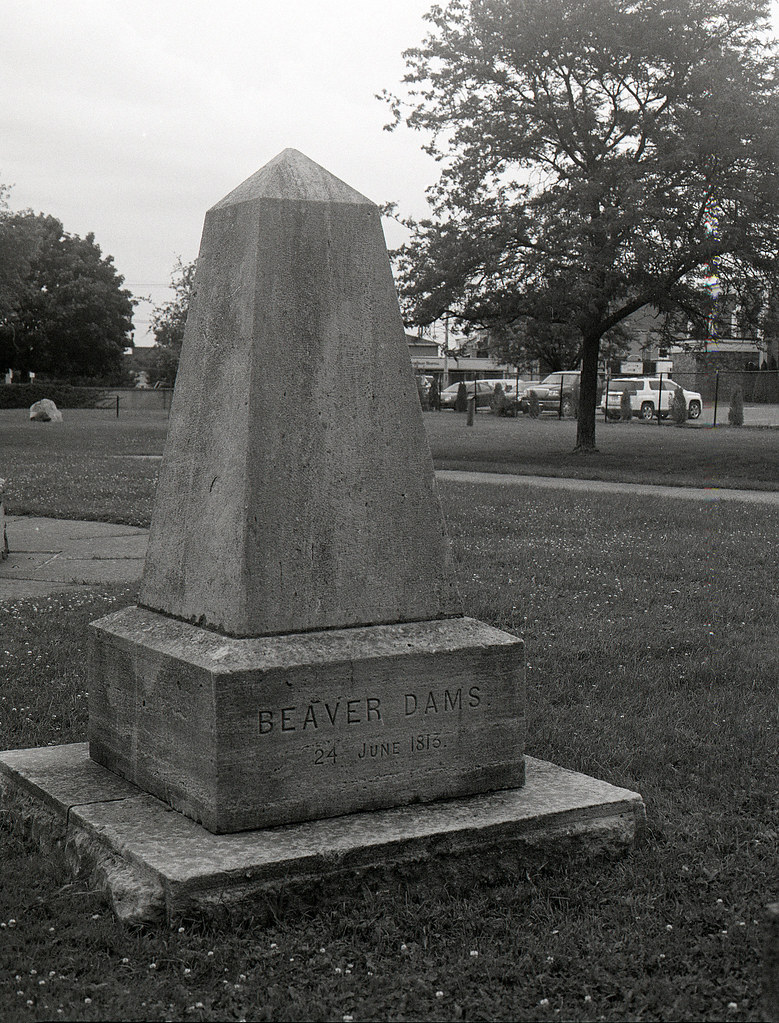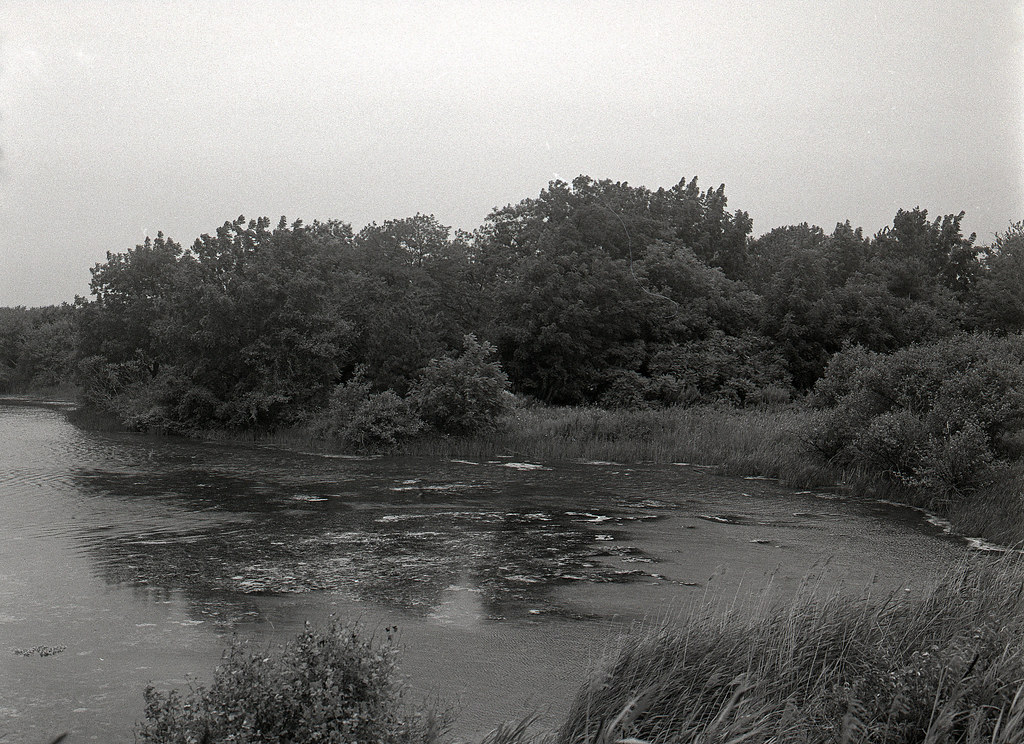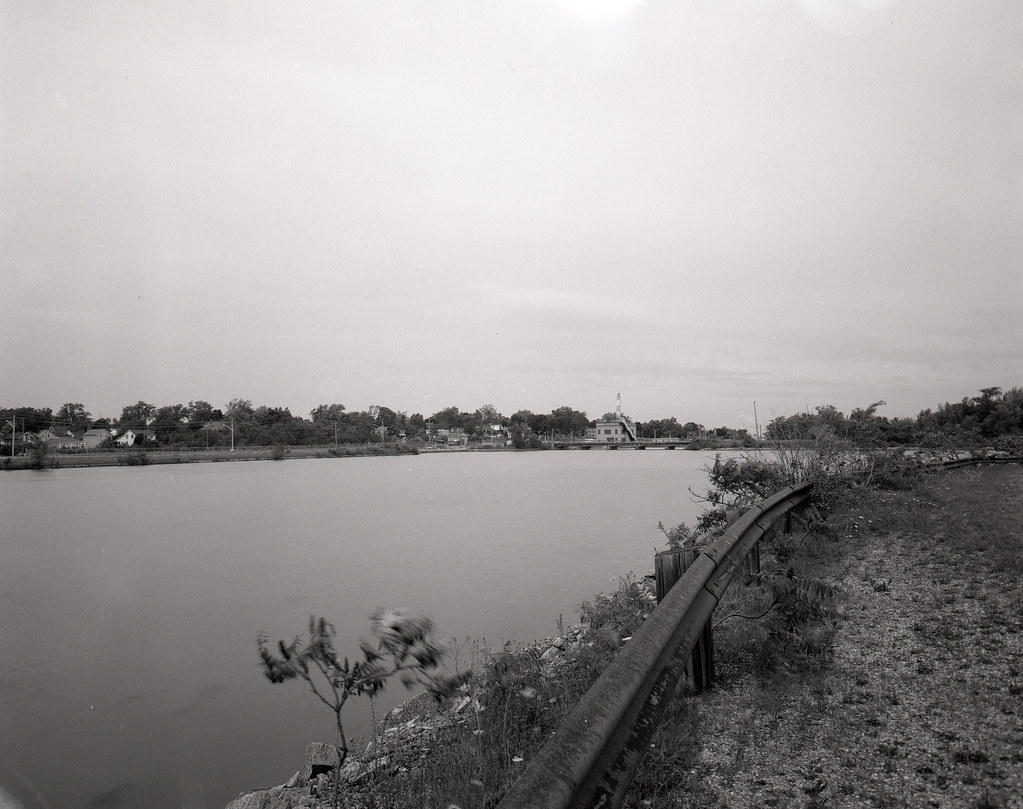One of the most controversial and convoluted battle in the War of 1812 is that of the Battle of Beaver Dams. It’s also been my most active posts in the project, at least my original posts. I have received more hate mail and rude comments (both of which will never be made public) so rather than let it stand as it is, I did what any good student of history would do, that is research more and learn more. In doing so I came across two books (both of which are cited at the bottom of this post) that have greatly opened my eyes to the war as a whole and will be used extensively in the creation of the final book for the project and in future blog posts.

Pentax 645 – SMC Pentax A 645 75mm 1:2.8 – Kodak TMax 400 – Kodak HC-110 Dil. E 7:00 @ 20C
Following the American retreat after being driven away from Stoney Creek and then again at Forty Mile Creek, and another defeat at Butler’s Farm, Dearborn lived in fear. The sickly general in charge of the 1813 campaign had pulled everything back to Fort George in Newark. And the British were no slouches had established several outposts, slowly taking back the Niagara Region. Dearborn found himself outmaneuvered and outgunned. The key to keeping the Americans pinned in was a triangle of outposts. At the apex was the DeCew house, stationed here was Lieutenant James FitzGibbon of the 49th and his group of volunteers from that regiment, known as the Bloody Boys, men he personally training in guerrilla tactics. Seven miles away at the mouth of Twelve Mile Creek with Major DeHaren and three companies of regular troops. The final point on the triangle was further up the lake sure on the heights above Twenty Mile Creek, the area’s commander, Lieutenant Colonel Cecil Bisshopp and a brigade of Light Troops. Also in the region was a squadron of Provincial Dragoons under Captain John Hall, and two bands of native warriors. The Mohawks under Captain John Norton and the Caughnawagas under Captain Dominque Ducharme.

Modified Anniversary Speed Graphic – Fuji Fujinon-W 1:5.6/125 – Fuji Neopan Acros 100 – Kodak Tmax Developer (1+4) 5:30 @ 20C
In the quiet village of Queenston, still under American occupation, a young loyalist wife, Laura Second, sets out early in the day on the 22nd of June, 1813. Her husband, Sargent James Secord left at home, still recovering from wounds he received at the Battle of Queenston Heights back in October of 1812. She had received some troubling information, that a column of American troops was heading to DeCew House to deal with the British stationed there. By nightfall she had travelled near twenty miles through the black swamp that blocks her path between Queenston and DeCew, dirty and tired she finds herself in the camp of some of Ducharme’s Caughnawagas, after some time manages to convince them to bring her to FitzGibbon at DeCew House. The young officer believes Secord, and orders John Norton to deploy his warriors incase the Americans do attack. As the 22nd dawns there is no sign of any Americans in the area. In fact the entire American force is safe behind the walls of Fort George or close by. FitzGibbon, no believe this loyalist woman, from a loyalist family, even marrying a fellow loyalist would lie to him, an officer in the King’s army, or at worst, be a traitor herself trying to lead him into a trap.

Pentax 645 – SMC Pentax A 645 75mm 1:2.8 – Kodak TMax 400 – Kodak HC-110 Dil. E 7:00 @ 20C
At Fort George, the moral among the troops is sinking, and sickness is spreading, both physical and through petty jealousy among the officers. At the center is General Dearborn, his command dwindling and consistently beaten by the British, specifically FitzGibbon and his bloody boys. What he needed was a victory, and there would be no better target than FitzGibbon. He ordered that a brigade be put together, and command given to Lieutenant Colonel Charles Boerstler, an annoyance to his command, often complaining when he was passed over, providing support and acting as guide was Doctor Cyrenius Chapin, who had for the past several months been leading raids against civilian targets in the region. There was no love between these two men, but even with Chapin’s complaints, Boerstler remained in command. Leaving immediately on the 23rd the column, supported by two artillery pieces set out from Fort George, arriving late at Queenston. They were on the move again by daybreak on the 24th, getting some sleep. They were surprised to find two scouts from Ducharme’s band in the village of St. Davids, killing one, and sending the other running. Before continuing their march. The scout rather than running back to camp, heads instead to report the column to Ducharme who is at Major DeHarren’s post. Ducharme, manages to convince the major to allow him to deploy his warriors along the road to ambush the column with the aid of Norton’s Mohawks, DeHarren agrees, then sends a scout to warn FitzGibbon at DeCew House.

Pentax 645 – SMC Pentax A 645 75mm 1:2.8 – Kodak TMax 400 – Kodak HC-110 Dil. E 7:00 @ 20C
In the American Column, Dr. Chapin is getting nervous, the area they were travelling had little cover save for the thick woods surrounding them, he was sure that a native ambush was in the area. Boerstler did not give this warning much credit instead continuing on. He wanted FitzGibbon. It turned out that Chapin was right and out of the woods came the war cries of the Caughnawagas. What happened next is muddy, each main player in the battle remembering it differently. Ducharme remembers the Mohawks fleeing with the first American musket volley, and that his own warriors managed to kill most of the American advance guard, pushing the Americans into a position to surrender. Boerstler believes the blame for the defeat lays with Chapin, who lead his column into a trap on purpose, and that the rouge doctor cut and run at a critical moment. Chapin of course blamed Boerstler that the ineffective Colonel sent him away at the critical moment to find a good spot to setup the artillery, pulling him off the pursuit driving away the natives. However it happened, the Americans found themselves by the noon hour, tired, running low on ammunition, and pinned in by hidden native warriors. Watching this all unfold was FitzGibbon, seeing his moment, and knowing that with his small group of regulars had no hope of defeating the Americans in open combat, and the Natives could leave at any moment, chose to win by guile. Riding in under a flag of truth, the brash officer, the student of the late Sir Isaac Brock, who had secure his commission and taught him all he knew on leading men and being a gentleman, demanded the surrender of the American column, making it rather clear that the Americans were surrounded by a far superior British force and that natives were angered to the point of massacre. Boerstler would have none of this, surrender to this unseen force, never, calling the bluff demands that he be shown this force. FitzGibbon replies that he must first consult with his commander, Major DeHarren.

Pentax 645 – SMC Pentax A 645 75mm 1:2.8 – Kodak TMax 400 – Kodak HC-110 Dil. E 7:00 @ 20C
But DeHarren is not near the area, but riding towards it, instead, FitzGibbon encounters Captain Hall’s dragoons. Hall upon learning of the situation, agrees, that should it be needed he would pretend to be DeHarren. Boerstler, agreeable, sends his subaltern to inspect this hidden army. The American officer, upon seeing Hall believes him to be DeHarren, Hall throwing himself into the role of the major, tells the officer that it would be humiliating to show his force, but again repeats that it is large enough to compel surrender. Upon returning with the news to Boerstler, the American colonel still wary asks for time to think about it, FitzGibbon again dropped a warning about his natives. With memories of River Raisin still fresh, is enough to compel surrender. Everything was falling into place that is until both Bisshopp and DeHarren (the real one) rides onto the scene, with everything threatening to unravel, FitzGibbon steps forward to DeHarren and quietly informs the major before he can issue his own surrender demands that the Americans were already his prisoner then louder asks if he can proceed to disarm the Americans. DeHarren shaken by this turn of events states that the Americans would be allowed to keep their weapons and begins to make preparations to march them out. Worried that the Americans should they catch site of the small number of regular troops that they might turn the tables on them, again speaks loudly to the major, asking if it was wise to march the armed Americans through woods populated by natives. Boerstler demands that DeHarren follow FitzGibbon’s advice. Unable to do anything else, DeHarren orders the Americans to ground their arms. By this point the Mohawks had returned to the sight and sprang forward to seize the American weapons, while FitzGibbon assures that they would not be harmed if they left their weapons on the ground. And thus, the battle, such as it was, was won.

Pacemaker Crown Graphic – Schneider-Kreuznack Angulon 1:6,8/90 – Kodak Plus-X Pan (PXP) – Kodak HC-110 Dil. B 5:00 @ 20C
It was Captain John Norton that said it best. “The Caughnawaga Indians fought the battle, the Mohawks got the plunder, and FitzGibbon got the credit.” FitzGibbon for his role in the battle was gazetted to Captain and transferred to the Glengarry Light Infantry. But if you ask any Canadian who the real hero in this battle was, the answer would be Laura Secord. It was her trek through danger, often having to avoid American patrols, which warned FitzGibbon of the impending attack. But by the time the young wife arrived at DeCew house, the Americans weren’t even planning such an attack, let along be in a position where she could learn about the attack. By the time Boerstler’s force reached Queenston, she had already been at DeCew house for a good 24-hours. So how did she get the information? That is a secret that she took to her grave. But her story, has over the centuries been the basis of one of many myths and legends that arose to help build up a mythos that it was the efforts of Canadians that won the war, downplaying the critical role of the British Regulars and all but stamping out the roll of the Natives that fought as well. It makes John Norton’s statement ring even truer, with the addendum, that Laura Secord made it all possible. Today much of the Beaver Dams battlefield is underwater, covered by the Welland Canal, the monuments to the battle moved to a memorial park in Thorold, Ontario. A new monument, with the battle from the view of Ducharme is located at Old Thorold Stone Road and Davis Road that expands upon the role of the natives. The DeCew House burned in the 1950s, but the ruins were stabilized and can be explored by the public. The Secord homestead is also a public museum, restored through the efforts of the Laura Secord Chocolate Company is located in Queenston, Ontario.
Written with Files From:
Collins, Gilbert. Guidebook to the Historic Sites of the War of 1812. Toronto: Dundurn, 2006. Print.
Hickey, Donald R. Don’t Give up the Ship!: Myths of the War of 1812. Urbana: U of Illinois, 2006. Print.
Berton, Pierre. Flames across the Border, 1813-1814. Markham, Ont.: Penguin, 1988. Print.
Web: www.brocku.ca/webfm_send/31314